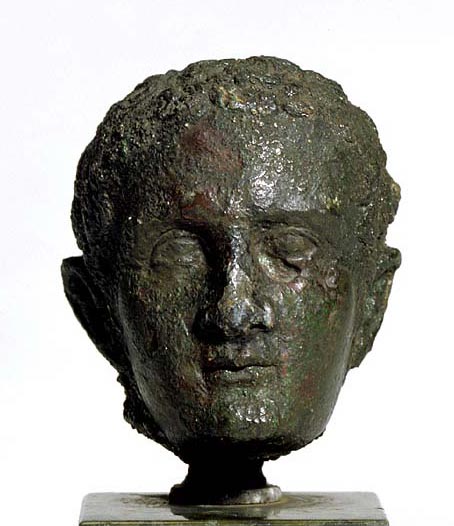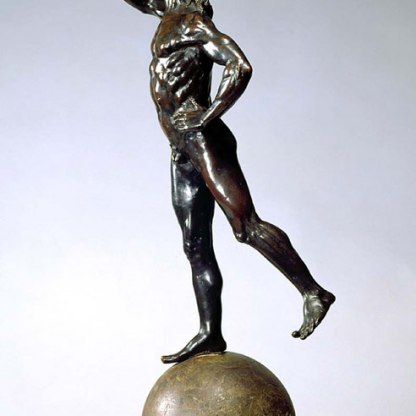Head of the Emperor Caligula

This small, corroded bronze head has been identified as a rare surviving image of Caligula, one of only a few that escaped destruction or re-cutting after the hated Emperor’s assassination in 41 BCE.
His full official name was Gaius Julius Caesar Germanicus. Caligula means ‘little boots’ and was an affectionate childhood nickname given to him by the soldiers under the command of his father Germanicus, for he would toddle round the camp wearing a miniature army uniform. Germanicus had been adopted by the Emperor Tiberius as his heir but died suddenly in 19 BCE. The great affection the people held for him was extended to his son, and when the unpopular Tiberius died in 37 CE, there was a sense of optimism about his young successor, only the third emperor Rome had known.
The euphoria was was short-lived. Paranoid about his own security, Caligula murdered those he suspected of plotting against him, including the leader of his guard, Macro, who had eased his succession in the first place. Unlike his predecessors, he assumed absolute power and demanded that he be treated as a god in his lifetime. He built a shrine to house a golden statue of himself, which was dressed every day in an outfit to match whatever the emperor himself was wearing. Caligula was said to have been so sensitive about his premature baldness that he made it a capital offence for anyone to gaze upon the hairless imperial pate, or to mention a goat in his presence.
This small bronze head does not, of course, look like the monster of depravity that subsequent historians have painted Caligula to be. Nor is he quite as physically repulsive as Suetonius, the first-century Roman historian, would lead us to believe. In an extended description of the Emperor’s uncomely appearance, this writer tells us that:
'... his face was naturally grim and ugly, and he contrived to make it even more savage by practising all kinds of awful and terrifying expressions in a mirror'
This is, however, an official image made during Caligula’s lifetime. It might have once been part of a full-length figure from a domestic shrine in a household keen to advertise their allegiance to the temperamental despot. It is in the tradition of portraits of the Julio-Claudian emperors, the first of whom, Augustus, can be seen on the obverse of a coin from the Fitzwilliam, left [CM.626-1936].
Caligula’s assassins were said to have been so full of loathing for their victim that they ate his flesh. However unlikely that may be, the Emperor’s body in stone and metal was certainly made to suffer. After his death Caligula was not deified, as Augustus and Tiberius had been, and he suffered a damnatio memoriae – his name was removed from all public buildings and rolls of honour. His successor Claudius stopped short of declaring the day of his death a public holiday, but his statues were removed from public view. Some were thrown into the Tiber – a great dishonour. Others were recut to resemble emperors of more blessed memory. And some were simply destroyed by a furious populace. Portraits on coins minted during his reign were defaced.
To this day, images of political leaders remain targets of protest and dissent. In 2002 a marble statue of former British Prime Minister Margaret Thatcher was decapitated by a member of the public concerned over Third World debt. And who can forget the images of Iraqi civilians, stamping and spitting upon the bronze statue of Saddam Hussein in Baghdad’s al-Fardus Square in April 2003, after it had been toppled by an American armoured vehicle?
Themes and periods
Data from our collections database
Head of Caligula
Legal notes
The Ricketts and Shannon Collection. Bequeathed by Charles Shannon, 1937
Acquisition and important dates
- Method of acquisition: Bequeathed
- Dates: 1937
Dating
cast
Place(s) associated
- Italy
Materials used in production
Read more about this recordOther highlight objects you might like
Suggested Curating Cambridge products
Sign up to our emails
Be the first to hear about our news, exhibitions, events and more…





